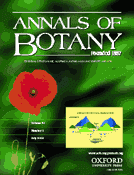
linkedin post 2020-09-17 04:33:41
STIMULUS RESPONSE. "That the various parts of plants communicate with each other has been established by many experiments. Various surgical treatments (such as removal of root or shoot or leaves, mimicking predation or other damage), resource stress (lack of light or water or minerals) or exposure of one part of a plant to varying resource levels, give rise to specific changes in growth and development elsewhere in the plant, indicating communication of the stimulus." http://aob.oxfordjournals.org/content/92/1/1.full View in LinkedIn



